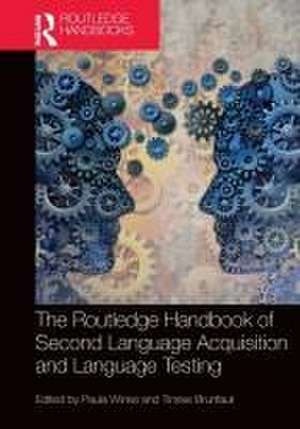The Routledge Handbook of Second Language Acquisition and Language Testing: The Routledge Handbooks in Second Language Acquisition
Editat de Paula Winke, Tineke Brunfauten Limba Engleză Paperback – 29 ian 2024
| Toate formatele și edițiile | Preț | Express |
|---|---|---|
| Paperback (1) | 443.10 lei 6-8 săpt. | |
| Taylor & Francis – 29 ian 2024 | 443.10 lei 6-8 săpt. | |
| Hardback (1) | 1569.42 lei 6-8 săpt. | |
| Taylor & Francis – 28 dec 2020 | 1569.42 lei 6-8 săpt. |
Preț: 443.10 lei
Nou
Puncte Express: 665
Preț estimativ în valută:
84.78€ • 88.53$ • 70.01£
84.78€ • 88.53$ • 70.01£
Carte tipărită la comandă
Livrare economică 15-29 aprilie
Preluare comenzi: 021 569.72.76
Specificații
ISBN-13: 9780367640491
ISBN-10: 036764049X
Pagini: 542
Ilustrații: 80
Dimensiuni: 178 x 254 x 31 mm
Greutate: 0.93 kg
Ediția:1
Editura: Taylor & Francis
Colecția Routledge
Seria The Routledge Handbooks in Second Language Acquisition
Locul publicării:Oxford, United Kingdom
ISBN-10: 036764049X
Pagini: 542
Ilustrații: 80
Dimensiuni: 178 x 254 x 31 mm
Greutate: 0.93 kg
Ediția:1
Editura: Taylor & Francis
Colecția Routledge
Seria The Routledge Handbooks in Second Language Acquisition
Locul publicării:Oxford, United Kingdom
Notă biografică
Paula Winke is a Professor of Second Language Studies and TESOL at Michigan State University, USA, where she specializes in the assessment of language proficiency for practical uses and the measurement of individual differences for SLA research.
Tineke Brunfaut is a Professor of Linguistics and English Language at Lancaster University, UK, where she specializes in language testing and second language reading and listening.
Tineke Brunfaut is a Professor of Linguistics and English Language at Lancaster University, UK, where she specializes in language testing and second language reading and listening.
Recenzii
"The Handbook of SLA and Language Testing is a wonderful volume that shows how SLA and language testing combined into one transdisciplinary research space has incredible power to move L2 learning theory into solid, new, and exciting grounds. Paula Winke and Tineke Brunfaut's stewardship over the chapters in this volume has given rise to a Handbook that will be read, consulted, and cited for years to come."
--Jamie Schissel, University of North Carolina, USA.
Cuprins
1. Introduction: Perspectives on ‘Knowing’ a Second Language: What are we seeking to measure? Part 1. Assessment Concepts for SLA Researchers 2. Validity Theory 3. Validating Assessments for Research Purposes 4. Language Proficiency: Definitions, Scales (ACTFL, CEFR, DLI, ILR) 5. Corpora, Test Development, Describing 6. SLA Ressearcher Assessment Literacy Part 2. Building Instruments for SLA Research 7. Test Design Cycle 8. Likert Scale Item Construction 9. Choosing Test Formats/Task Types 10. Designing Multiple Choice Questions 11. Pilot Testing: How and Why 12. Scoring Approaches: Rubrics/Scales 13. Raters: Behavior and Training Part 3. Measuring Individual Differences 14. Measuring Aptitude 15. Measuring Motivation 16. Measuring Working Memory 17. Measuring Anxiety 18. Measuring Willingness to Communicate (WTC)/Interact Part 4. Measuring Language Development 19. Measuring Complexity, Accuracy, Fluency (CAF) 20. Measuring Vocabulary Development 21. Measuring Lexicogrammar 22. Measuring Morphosyntax/Grammatical Knowledge 23. Measuring Phonology 24. Measuring Pragmatics 25. Measuring L2 Reading 26. Measuring L2 Listening 27. Measuring L2 Speaking 28. Measuring L2 Writing 29. Measuring Implicit/Explicit Learning 30. Measuring Task-based Performance 31. Measuring Literary Study 32. Measuring Interactional Competence 33. Measuring Across Languages 34. Measuring Intercultural Competence 35. Measuring Acquisition in Non-Formal Settings 36. Measuring One’s Own Language Development Part 5. Testing Specific Populations 37. Testing Bi/Multilingual Learners 38. Testing the L2 of Young Learners 39. Testing the L2 of Learners with Specific Learning Differences 40. Testing Heritage Learners 41. Testing Sign Language Learners Part 6. Measurement Principles for SLA Researchers 42. Statistical Modelling of SLA Theories: Connecting Test Performance to Construct 43. Equivalating Test Forms in SLA Pre- and Post-Test Design Research 44. Reliability Analyses: Evaluating Error 45. Statistical Significance Testing and Effect Sizes 46. Non-Parametric Statistics
Descriere
This handbook is the first comprehensive synthesis of these distinct yet interrelated fields of SLA and language testing. Uniquely, this handbook is written for both second language acquisition researchers interested in the applications of language testing, and language testers interested in the SLA theory underpinning their work.













